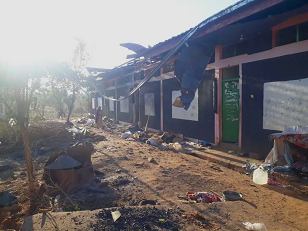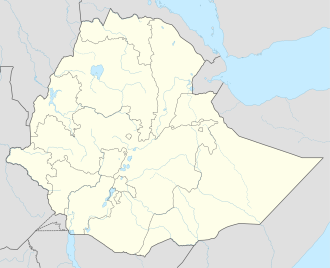| Dedebit Elementary School airstrike | |
|---|---|
| Part of the Tigray war | |
 Aftermath of the airstrike | |
Location of Dedebit in Tigray Region, Ethiopia | |
| Location | 14°04′24″N37°45′52″E / 14.07344°N 37.76440°E Dedebit, North Western Zone, Tigray Region, Ethiopia |
| Date | 7–8 January 2022 ~23:00–00:00 (UTC+3) |
Attack type | |
| Weapon | MAM-Ls from a Bayraktar TB2 |
| Deaths | 56–59 |
| Injured | 30–126+ |
| Perpetrators | |
In the late hours of 7 January 2022 (Ethiopian Christmas), the Ethiopian Air Force (ETAF) carried out an airstrike on a camp for internally displaced persons (IDP) set up in Dedebit Elementary School, located in the Tigray Region of Ethiopia. Between 56 and 59 people were killed in the attack, and at least 30 others were left injured.
Contents
- Background
- Tigray war
- Airstrike
- Investigations
- Aftermath
- Reactions
- See also
- Notes
- References
- Bibliography
- External links
The month before the airstrike, the Tigray People's Liberation Front (TPLF) withdrew its forces after a failed offensive towards Addis Ababa, with officials from the Ethiopian federal government asserting they had reduced the TPLF's capacity to engage in warfare. In early January 2022, despite outward appearances of support for a peaceful resolution to the Tigray war (including the release of Tigrayan political prisoners), the ETAF began launching a series of airstrikes on Tigray between 7 and 14 January. The deadliest attack of this campaign happened in Dedebit, where a Bayraktar TB2 combat drone launched three bombs at a school-turned-IDP camp. According to survivors, aid workers, and investigators from Human Rights Watch (HRW) and the United Nations (UN), the camp was not being used for military purposes.
The attack was condemned by the TPLF and international observers. Investigators described it as a war crime, and particularly as an intentional and disproportionate violation of the law regarding the safety of civilians. The airstrike caused humanitarian agencies in the immediate area to suspend their activities, and prompted the relocation of Dedebit's displaced persons to other parts of Tigray. Neither Ethiopia nor Turkey (the most likely supplier of the TB2 drone) commented on the attack.



